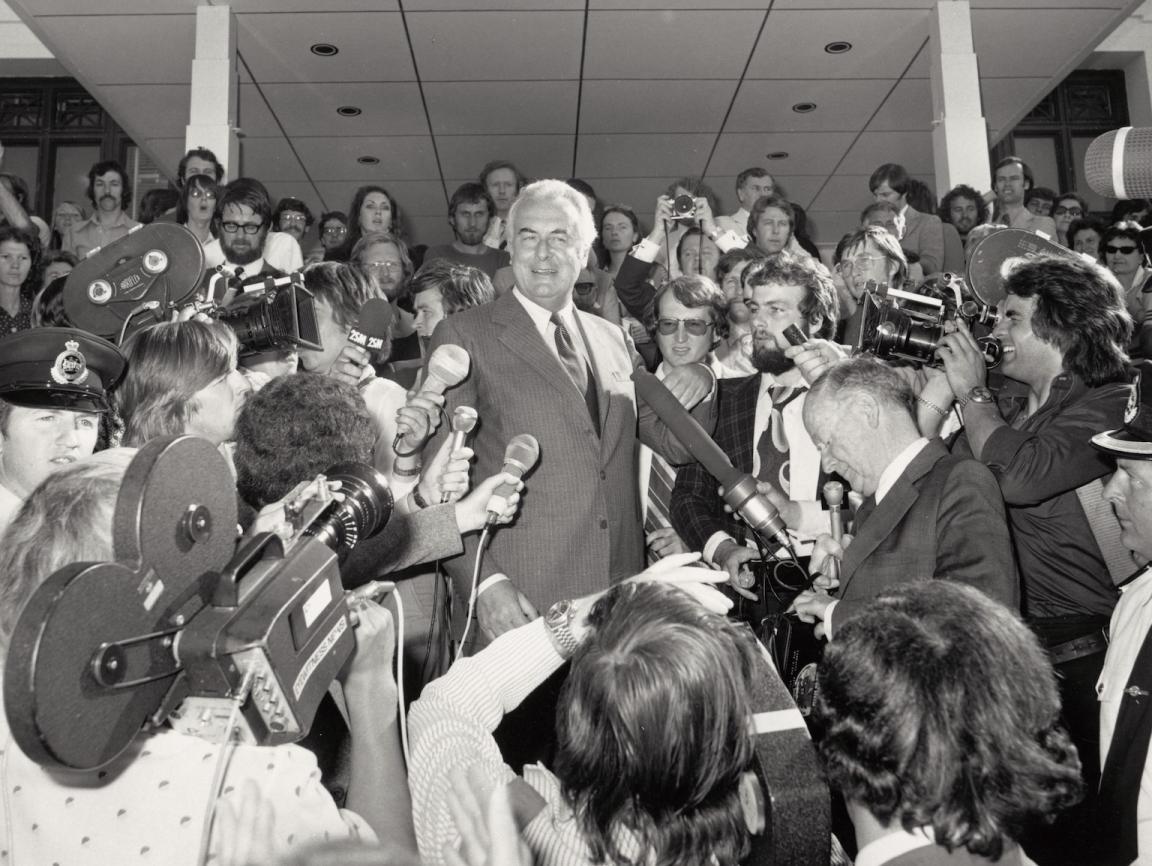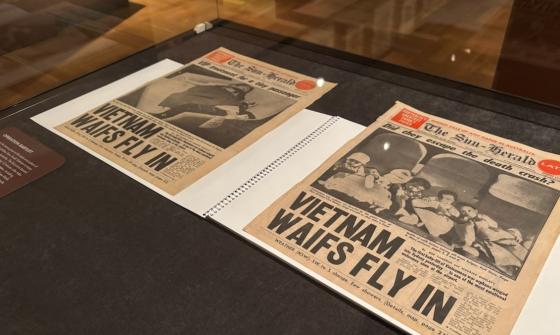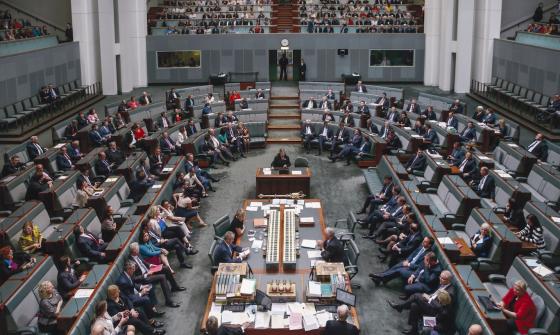Images of the Dismissal
11 November 2025 marks the 50th anniversary of the ‘Dismissal’, one of the most controversial events in Australian political history. The passing of time has not reduced the significance of this event, nor the passion with which it is debated by scholars and politicos.

Australian Information Service, Gough Whitlam speaking on the steps of Parliament House, Parliament House, Canberra, 11 November 1975, nla.gov.au/nla.obj-147274349
Australian Information Service, Gough Whitlam speaking on the steps of Parliament House, Parliament House, Canberra, 11 November 1975, nla.gov.au/nla.obj-147274349
What is the Dismissal?
The Dismissal, as it is popularly known, relates to the extraordinary events that unfolded on the 11 November 1975 at the official residence of the Governor-General at Yarralumla.
In a series of carefully coordinated meetings, Governor-General Sir John Kerr dismissed Gough Whitlam from the office of Prime Minister. He then commissioned the Opposition Leader, Malcolm Fraser, as caretaker Prime Minister. A federal election was held shortly afterwards on 13 December and confirmed Fraser in the office.
While political power was transferred peacefully at the election, Kerr’s dismissal of Whitlam was seen by many as a serious break of constitutional conventions and damaging to Australian democracy. On the day of his dismissal, Whitlam denounced Kerr’s actions in one of the most famous speeches in Australian political history, made on the steps of the parliament:
Well may we say God save the Queen because nothing will save the Governor-General.
Collecting the Dismissal
As a historian working at the Library, this anniversary has provided me with the opportunity to dig into our collections and reflect on the role that memory institutions play in documenting major historical events like the Dismissal.
It will be no surprise for readers to hear that the Library holds thousands of collection items relating to the events that unfolded in Canberra in late 1975. There are the first takes on events written by journalists like Laurie Oakes and Paul Kelly, both who had ring-side seats to the constitutional crisis. There are also the memoirs of the major participants including Gough Whitlam, Malcolm Fraser and Sir John Kerr, all who attempt to set the record straight, at least in terms of their own experience.
On Trove you can pull up the day-to-day accounts of the machinations in Parliament House in The Canberra Times in the lead up to the events of 11 November. There is also political ephemera from protests and campaign material from the 1975 election campaign as well as original editorial cartoons by artists like Alan Moir.
The Library also holds a comprehensive collection of scholarly works analysing the political and constitutional significance of the Dismissal. Debates amongst political scientists, constitutional lawyers and historians continue. Professor Jenny Hocking’s The Palace Letters : the Queen, the governor-general, and the plot to dismiss Gough Whitlam is one of the most important recent contributions.
Picturing the event
For me, some of the most evocative material relating to the Dismissal are the photographs taken by the Australian Information Service (AIS). In 1975 the AIS was the government agency responsible for producing promotional material for the Australian government. AIS photographers were regularly sent to document events and celebrations around the country. These photographs are now held by the Library and the National Archives of Australia, and provide an amazing resource for anyone interested in Australian history.
Perhaps the most famous image taken on the day is the one in which Whitlam can be seen gazing over the shoulder of the Governor General’s Official Secretary David Smith who is reading the proclamation dissolving parliament. Looking at the tilt of Whitlam’s head, you can’t help but suspect that he was reading the proclamation over Smith’s shoulder and was beginning to compose his famous line, ‘well may we say…’.

Mr David Smith, official secretary to the Governor-General, reads the proclamation dissolving both Houses of Parliament on the steps of Parliament House, Canberra, on November 11, 1975. Behind him is Mr Whitlam, [1], nla.gov.au/nla.obj-147276195
Mr David Smith, official secretary to the Governor-General, reads the proclamation dissolving both Houses of Parliament on the steps of Parliament House, Canberra, on November 11, 1975. Behind him is Mr Whitlam, [1], nla.gov.au/nla.obj-147276195
Other photographs taken in front of Parliament House capture the growing crowd of protestors. In this image Malcolm Fraser can be seen striding towards his car, confident in the knowledge that he had just been made caretaker Prime Minister. Fraser looks well pleased with himself, despite the protestors yelling in the background.

Malcolm Fraser walking beside car at Parliament House, Canberra, 11 November 1975, nla.gov.au/nla.obj-147275242
Malcolm Fraser walking beside car at Parliament House, Canberra, 11 November 1975, nla.gov.au/nla.obj-147275242
While the AIS photos of the Dismissal are well known, it is another image, taken in Sydney, which is my personal favourite. It was taken by Robert McFarlane, one of Australia’s great photographers whose images are also held by the Library.
McFarlane was far from the action in Canberra, but his instinct for creating a powerful image led him to Martin Place in the late afternoon of the 11 November 1975. There he snapped a newspaper hawker holding up the afternoon edition of the Daily Mirror with its headline screaming: ’KERR SACKS GOUGH!’.

Robert McFarlane, Newspaper vendor holding a copy of the Daily mirror with the headline 'Kerr sacks Gough', Martin Place, Sydney, 1975, nla.gov.au/nla.obj-152388014
Robert McFarlane, Newspaper vendor holding a copy of the Daily mirror with the headline 'Kerr sacks Gough', Martin Place, Sydney, 1975, nla.gov.au/nla.obj-152388014
The reason I like this photograph is that it is not of one of the key political figures involved in the crisis but rather documents how the Australian public were receiving the news of the event. This photograph transports me into the viewpoint of workers emerging from their offices in the late afternoon only to discover that their Prime Minister had been sacked.
Events had taken a turn which no one had expected, and Australia had been changed forever. McFarlane’s photo of the bedraggled newspaper seller holding up the Daily Mirror somehow captures how shocking and disruptive the Dismissal was.
These photographs and others are featured in the 1975: Living in the Seventies exhibition currently on display at the Library until 9 March 2026.
Visit us
Find our opening times, get directions, join a tour, or dine and shop with us.



